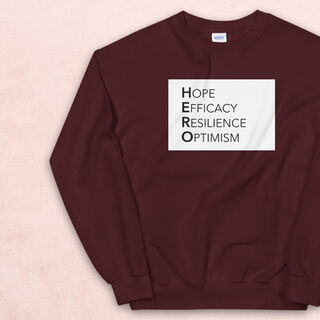Optimism
Up Your Mental Game Using "HERO"
The four elements of psychological capital.
Posted June 28, 2020 Reviewed by Kaja Perina
H-E-R-O is a positive intervention tool that is easy to recall, as the acronym reminds one to express hero traits. The association to a super-being, that in the end wins, is embedded in our film culture. What if that were our mentality- that despite the hurdles before us, we will succeed- how would our experiences change?
Positive psychological capital (PsyCap) is “an individual's positive psychological state of development" and has been vastly studied for its benefits in the workplace. It also enhances life satisfaction, health outcomes, and well-being. PsyCap is identified by the four elements of HERO.
Think of something that causes you negative emotions and consider how would you feel if you looked at this issue with:

Hope: expecting to achieve your goals and creating pathways to get there
Efficacy: believing in your abilities to take on challenging tasks
Resilience: sustaining and bouncing back to attain success
Optimism: remaining positive about succeeding now and in the future
HERO helps cultivate a positively inclined mental foundation that increases the ability to accomplish a goal or overcome adversity. It can be used to reverse framing experiences through a lens of pessimism, low self-esteem, or anxiousness to one of faith, confidence, and enthusiasm.
The more HERO is rehearsed, the easier it becomes to default to these traits as a first response to challenges. As with any new habit, it is a matter of making it stick. Ask questions that ignite HERO responses. Self inquiry shifts the brain from reactive impulses to the ability to evaluate while considering new possibilities.
Use the following exercises to:
1) Assess HERO cognitively
2) Connect with HERO emotionally
HOPE:
“What pathways and resources do I have to move me closer towards my goal?”
EFFICACY:
“What traits have I used to succeed in the past, and who can I gain advice from who has experienced something similar?”
“What is the reality of this situation, and what purpose can I derive from it?”
OPTIMISM
"How can this help me better handle difficulties or bigger opportunities now and in the future?"
If your responses feel overly ambitious, the brain may shut down. Check in with yourself trusting you will know what feels encouraging or attainable even if in the long run. When we foresee what can become obstacles and devise potential solutions, the brain accepts these as realistic projections. This can then be reinforced with positive ‘self-talks’ that influence how we perceive and believe. Bring HERO into these personal thoughts.
FROM THE INSIDE OUT
Through visualization, the brain-body connection is strengthened whereby we become one with the new behavior or activity. During this state of being, responses are unforced and exploratory, optimal for learning. While experiencing positive emotions in this space, dopamine is released, linked to motivation, and helpful for new habit formation.
ACTIVATE HERO ON THE INSIDE
Mental rehearsals train our minds to process through the filter of HERO rather than one of worry or whatever the current default is. Repetition overrides the default wiring to become the new automatic response.
- Imagine a time when you felt HERO at its greatest capacity. When did you feel the most optimistic about a challenging goal and despite how many walls you were up against, you pushed through?
- Notice the physiological benefits when you choose hope, efficacy, resilience, or optimism. Amplify these “feel good” emotions while identifying where in the body this energy shows up such as in your heart. Release, then bring back the good feelings into the space once again, placing your hand there for later recall of the desired emotion.
- Within this elevated mental state, the mind is now primed to thrive. Apply the questions above to a current obstacle. Use your responses as a guide to create a new visualization. Allow your mind to wonder onto newly discovered pathways as this may move you closer to your goal.
ACTIVATE HERO ON THE OUTSIDE
- Use HERO with daily micro-goals so the brain feels rewarded by small wins and will take on more challenging situations. For example, in traffic, instead of being stressed, use HERO to redirect to a better choice such as, "I get to use this time to listen to a TED Talk related to my goal!" You can also use HERO prompting questions to process through a new concern. Remember, this is on-going mental training.
- To consciously activate HERO, touch the area of your body where positive emotions showed up during visualization. For some, it is the heart-space. This is known as “anchoring,” bringing to real life the experience of the internal work through a physical touch of that same area. The more specific your imagery, the easier it will be to tap into that same emotional life or frame of mind when you need it most.
- Master the habit of expressing these traits by paying forward your HERO to family, friends, and colleagues. Ask them HERO questions to remind them of their skills, ability to overcome, life's purpose, and that they too can be victorious.
A superhero has abilities that the average person does not. Choosing to take on the small stuff and the bigger issues through the lens of HERO is one such feat. Select an area in your life in which to activate your HERO today! In mastering just one of the four traits, the others come into play.
References
Fred Luthans, et al. (2007).
Luthans, Avey, & Patera (2008a).
Fred Luthans, et al. (2006).
Lorenz, Beer, Putz, & Heinitz (2016).
Donaldson et. al. (2019a).
Journal of Organizational Behaviour J. Organiz. Behav. 27, 387-393 (2006).
H. Jiang, MP White, MD Greicius, LC Waelde, D. Spiegal-Cerebral (2017).




